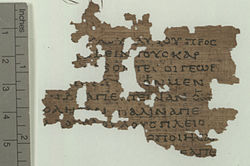
Back Evangelie volgens Matteus Afrikaans የማቴዎስ ወንጌል Amharic Godspell Mattheus ANG إنجيل متى Arabic ܟܪܘܙܘܬܐ ܕܡܬܝ ARC انجيل متى ARZ Evanxeliu de Matéu AST Matfey İncili Azerbaijani متی اینجیلی AZB Evangelium noch Matthäus BAR

| Part of a series on |
| Books of the New Testament |
|---|
 |
The Gospel of Matthew[a] is the first book of the New Testament of the Bible and one of the three synoptic Gospels. It tells the story of who the author believes is Israel's messiah (Christ), Jesus, his resurrection, and his mission to the world.[3] Matthew wishes to emphasize that the Jewish tradition should not be lost in a church that was increasingly becoming gentile.[4][5] The gospel reflects the struggles and conflicts between the evangelist's community and the other Jews, particularly with its sharp criticism of the scribes, chief priests and Pharisees[6] with the position that the Kingdom of Heaven has been taken away from them and given instead to the church.[7]
Scholars find numerous problems with the traditional attribution to the Apostle Matthew, though it is possible the gospel incorporates a source written by the disciple.[8][9][10] The predominant scholarly view is that it was written in the last quarter of the first century by an anonymous Jew familiar with technical legal aspects of scripture.[11][10] Most scholars think Matthew used the Gospel of Mark and the hypothetical sayings Gospel Q (which consists of the material Matthew shares in common with Luke)[12][13] and is the product of the second generation of the Christian movement, though it draws on the memory of the first generation of the disciples of Jesus.[14][15] Alternative hypotheses that posit direct use of Matthew by Luke or vice versa without Q are increasing in popularity within scholarship.[16][17]
- ^ ESV Pew Bible. Wheaton, IL: Crossway. 2018. p. 807. ISBN 978-1-4335-6343-0. Archived from the original on 3 June 2021.
- ^ "Bible Book Abbreviations". Logos Bible Software. Archived from the original on 21 April 2022. Retrieved 21 April 2022.
- ^ Luz 2005b, pp. 233–34.
- ^ Davies & Allison 1997, p. 722.
- ^ Storkey 2022, p. 84.
- ^ Burkett 2002, p. 182.
- ^ Strecker 2000, pp. 369–70.
- ^ Allison, Dale (2010). The Gospels. Oxford University Press. p. 27. ISBN 978-0199580255.
- ^ Theissen, Gerd; Maloney, Linda M. (2011). The New Testament: A Literary History. G - Reference, Information and Interdisciplinary Subjects Series. Fortress Press. p. unpaginated. ISBN 978-0-8006-9785-3.
- ^ a b Duling 2010, pp. 301–02.
- ^ Burkett 2002, p. 174.
- ^ Duling 2010, p. 306.
- ^ Turner 2008, pp. 6–7.
- ^ Dunn, James (2017). Who Was Jesus?. Church Publishing. p. 4. ISBN 978-0898692488.
- ^ Scholtz 2009, pp. 34–35.
- ^ Runesson, Anders (2021). Jesus, New Testament, Christian Origins. Eerdmans. ISBN 9780802868923.
- ^ The Synoptic Problem 2022: Proceedings of the Loyola University Conference. Peeters Pub and Booksellers. 2023. ISBN 9789042950344.
Cite error: There are <ref group=lower-alpha> tags or {{efn}} templates on this page, but the references will not show without a {{reflist|group=lower-alpha}} template or {{notelist}} template (see the help page).
© MMXXIII Rich X Search. We shall prevail. All rights reserved. Rich X Search